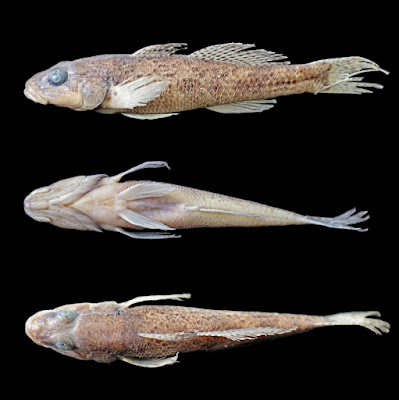Abstract
Microdous (Gobiiformes: Odontobutidae) is a genus of freshwater sleepers distributed in southern China and Vietnam. There are two described species in this genus, M. chalmersi widely distributed in Hainan Island and Guangxi province of China and M. amblyrhynchos with a very restricted distribution range in Baise, Guangxi. It has been reported that M. chalmersi of Guangxi might be a cryptic species, which is different from M. chalmersi of Hainan. Here, we describe the cryptic species from Guangxi as a new species, Microdous hanlini, and compare it with the other species of Microdous. Microdous hanlini can be distinguished from M. chalmersi by its wider head (head width/head length = 0.51–0.58 vs. 0.48–0.53 in M. chalmersi) and wider interorbital width (interorbital width/head length = 0.15–0.19 vs. 0.09–0.13 in M. chalmersi). Microdous hanlini can be distinguished from M. amblyrhynchos by its longer snout, (snout length/head length = 0.29–0.35 vs. 0.26–0.28 in M. amblyrhynchos); slenderer head (head width/head length = 0.51–0.58 vs. 0.61–0.65); and protruding eyes (vs. not protruding). Phylogenetics analyses based on partial sequence of cytochrome c oxidase subunit I (COI) gene (~1500 bp) showed that M. hanlini, M. chalmersi and M. amblyrhynchos formed reciprocal monophyletic clades and M. hanlini is more closely related to M. amblyrhynchos than to M. chalmersi. Genetic distance between the three species is greater than the interspecific distance between some species of Odontobutis.
Key words: Odontobutidae, skin teeth, freshwater sleepers, taxonomy, cryptic species
 |
| Microdous hanlini sp. nov., SOU1801015–8, holotype, 112.0 mm standard length, Du’an, Guangxi. A lateral B ventral C dorsal. |
Microdous hanlini Wang, He & Li, sp. nov.
Diagnosis. The species M. hanlini can be distinguished from M. chalmersi (Nichols & Pope, 1927) by the following characteristics: wider head, head width/head length = 0.51–0.58 (vs. slender head, head width/ head length = 0.48–0.53); wider interorbital width, interorbital width (bone)/head length = 0.15–0.19 (vs. slender head and narrow interorbital width, interorbital width (bone)/head length = 0.09–0.13). The species can be distinguished from M. amblyrhynchos by the following characteristics: snout pointed, snout length/head length ratio 0.29–0.35 (vs. blunt snout, snout length/head length ratio 0.26–0.28); slenderer head, head width/ head length = 0.51–0.58, (vs. head width/head length =0.61–0.65); eye large and protruding outward (vs. eye not protruding) (Fig. 3, Table 1). The species M. hanlini can be distinguished from Sineleotris saccharae by absence of dark band under eye. The species M. hanlini can be distinguished from Sineleotris namxamensis by the following characteristics: lateral scale rows 40-43 (vs. 36-39); transverse scale rows 14-16 (vs. 12-14). These distinguishing features showed no difference between male and female individuals of M. hanlini (Table 2.)
...
Etymology. The species name is named after Prof. Hanlin Wu in honor of his significant contributions to the study of the gobiiform fishes of China.
Fangxin WANG, Mulan WEI, You HE and Chenhong LI. 2024. Microdous hanlini (Gobiiformes: Odontobutidae), A New Species of the fine-toothed Sleepers from Guangxi, China. Zootaxa. 5477(3); 367-379. DOI: doi.org/10.11646/zootaxa.5477.3.6
